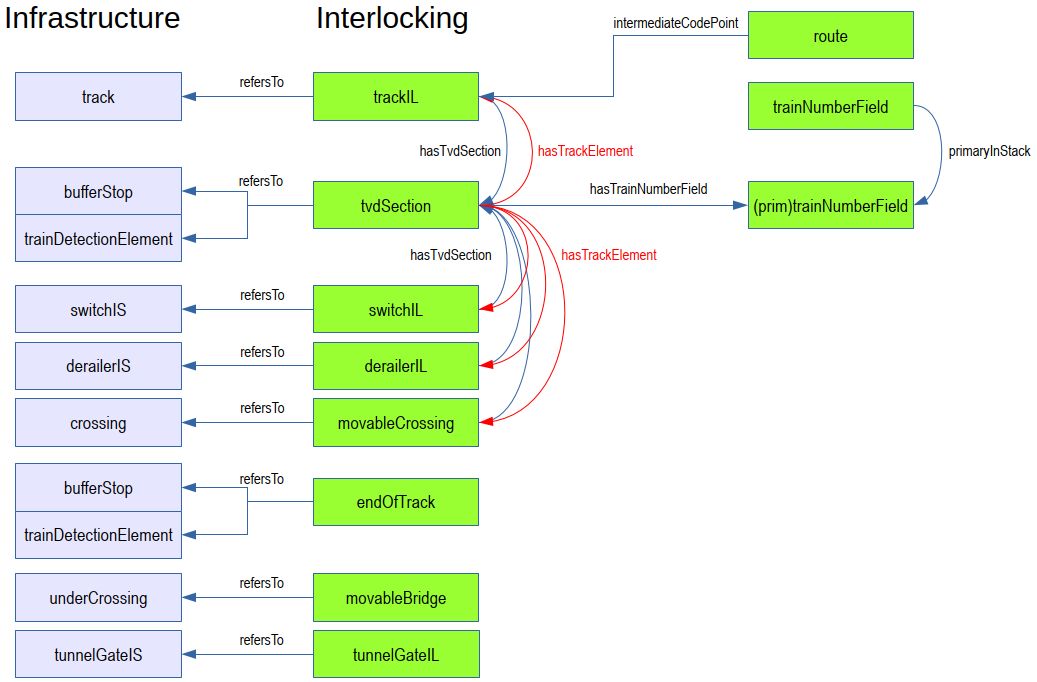Introduction
Documentation
Syntax
|
|
| Documentation
|
list of various assets which are related to one single infrastructure manager
|
| Subschema
|
interlocking
|
| Parents*
|
assetsForInterlockings
|
| Children
|
combinedRoutes (0..1), conflictingRoutes (0..1), dangerAreas (0..1), dangerPoints (0..1), derailersIL (0..1), designator (0..*), destinationPoints (0..1), elementState (0..*), emergencyStopAreas (0..1), endOfTracks (0..1), genericDetectors (0..1), interfaces (0..1), keyLocksIL (0..1), keys (0..1), levelCrossingsIL (0..1), linesideElectronicUnitsIL (0..1), localOperationAreas (0..1), movableBridges (0..1), movableCrossings (0..1), overlaps (0..1), permissionZones (0..1), powerSuppliesIL (0..1), routeRelations (0..1), routeReleaseGroupsAhead (0..1), routeReleaseGroupsRear (0..1), routeStatusIndicators (0..1), routes (0..1), shuntingZones (0..1), signalIndicators (0..1), signalsIL (0..1), stationIndicators (0..1), switchesIL (0..1), tracksIL (0..1), trainNumberFields (0..1), tunnelGatesIL (0..1), tvdSections (0..1), workZones (0..1)
|
Attributes:
- id: the identifier of the object; this can be either of type xs:ID or UUID (obligatory;
xs:ID); compare: Dev:Identities
|
*Notice:
Elements may have different parent elements. As a consequence they may be used in different contexts.
Please, consider this as well as a user of this Wiki as when developing this documentation further.
Aspects that are only relevant with respect to one of several parents should be explained exclusively in the documentation of the respective parent element.
|
|
|
| Documentation
|
list of various assets which are related to one single infrastructure manager
|
| Subschema
|
interlocking
|
| Parents*
|
assetsForInterlockings
|
| Children
|
combinedRoutes (0..1), conflictingRoutes (0..1), dangerPoints (0..1), derailersIL (0..1), designator (0..*), destinationPoints (0..1), endOfTracks (0..1), genericDetectors (0..1), interfaces (0..1), keyLocksIL (0..1), keys (0..1), levelCrossingsIL (0..1), localOperationAreas (0..1), movableBridges (0..1), movableCrossings (0..1), overlaps (0..1), permissionZones (0..1), powerSuppliesIL (0..1), routeRelations (0..1), routeReleaseGroupsAhead (0..1), routeReleaseGroupsRear (0..1), routeStatusIndicators (0..1), routes (0..1), shuntingZones (0..1), signalIndicators (0..1), signalsIL (0..1), stationIndicators (0..1), switchesIL (0..1), tracksIL (0..1), trainNumberFields (0..1), tunnelGatesIL (0..1), tvdSections (0..1), workZones (0..1)
|
Attributes:
- id: unique identifier (obligatory;
xs:string; patterns: (urn:uuid:)?[0-9a-fA-F]{8}-[0-9a-fA-F]{4}-[0-9a-fA-F]{4}-[0-9a-fA-F]{4}-[0-9a-fA-F]{12}|{[0-9a-fA-F]{8}-[0-9a-fA-F]{4}-[0-9a-fA-F]{4}-[0-9a-fA-F]{4}-[0-9a-fA-F]{12}}); compare: Dev:Identities
|
*Notice:
Elements may have different parent elements. As a consequence they may be used in different contexts.
Please, consider this as well as a user of this Wiki as when developing this documentation further.
Aspects that are only relevant with respect to one of several parents should be explained exclusively in the documentation of the respective parent element.
|
This element does not appear in railML® 3.1 within the IL subschema. It is available only in railML® 3.2, 3.3. Do not hesitate to contact railML.org for further questions.
Changes 3.1→3.2
There exists an overview of all changes between railML® 3.1 and railML® 3.2 on page Dev:Changes/3.2.
Introduced with version 3.2.
Changes 3.2→3.3
There exists an overview of all changes between railML® 3.2 and railML® 3.3 on page Dev:Changes/3.3.
The parents have been changed.
The children have been changed.
The attributes have been changed.
Semantics
Best Practice / Examples
The element contains a lot of containers for elements to decribe their functional characteristics in use of the interlocking domain. These are track related, route related objects and other system assets. Per instance of this element all included assets must belong to one infrastructure manager, which is referred here, i.e. they follow the same set of operational rules and definitions. There can be only one collection of assets within one interlocking data set. Different states of network evolution would cause different objects due to requirements of uniqueness concerning ID.
The physical features of tracks and trackside components (“track assets”) are described in the infrastructure subschema, and these object’s identities are referenced from the interlocking schema. Examples of track assets are: signals, switches, and TVD sections. Whereas the infrastructure subschema focus on the characteristics of the hardware the interlocking subschema concentrate on the more logical characteristics relevant for interlocking issues. Thus the interlocking subschema adds more information to some infrastructure elements.
Within the entire railML schema there are no different namespaces used. Subsequently some elements (types) in interlocking subschema had to be renamed in order to avoid collision with already existing elements in infrastructure subschema. In such cases just the suffix “IL” was added to the name, e.g. signalIS vs. signalIL.
The element of <assetsForInterlocking> is not only a collection of track assets but including some interlocking system components (“system assets”) and functional combinations like routes or restricted areas. Examples of system assets are anything not strictly related to track position like communication systems, power supply systems and diagnostic systems. The various kinds of assets have individual containers, which each hold an unlimited number of objects.
The figure below shows the principles of the reference relations between elements in interlocking domain and their relation to elements in infrastructure domain.

Additional Information
Notes
This element was created in version 3.2 by renaming it from <assetsForIL> in order to avoid abbreviations in element names.
Open Issues
